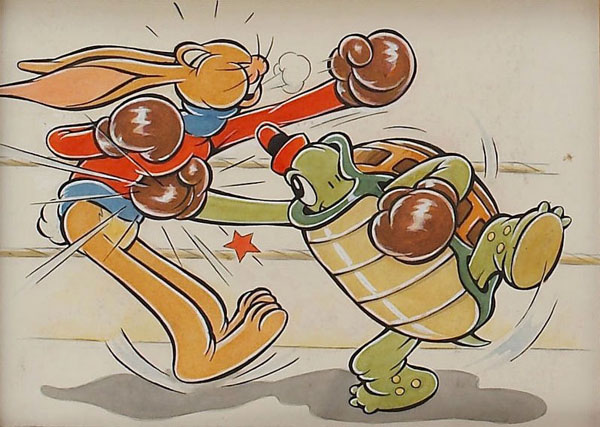
This week’s animator breakdown features one of my absolute favorite Disney animated shorts. Its been at the top of my list, right from the very beginning!
In October 1935, young assistant animator Ward Kimball submitted a story outline featuring Toby Tortoise and Max Hare in a boxing match, based on the success of the Academy-Award winning The Tortoise and the Hare. Early development continued until December, with sketch artist Bob Kuwahara, Joe Grant and Bill Cottrell as the story directors. During production of the film, Kimball expected a hundred-dollar bonus for writing the story. Instead, he received a check for half that amount from Paul Hopkins, the studios personnel manager, the reason given that Kimball had only been at the studio for a short amount of time; he was hired at the studio in early April 1934. Kimball still resented this mistreatment in later years.
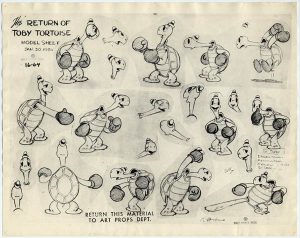 Like Mickeys Polo Team, released earlier in 1936, several characters from other Silly Symphonies are spectators in the battle between Toby and Max. The sultry Jenny Wren, from Who Killed Cock Robin (1935), plays a significant part in the film, when the predominantly male crowd gives her their undivided attention as she struts in to her seatamong them Donald Duck, Goofy, Horace Horsecollar, the Big Bad Wolf and the ruthless Dirty Bill from The Robber Kitten.
Like Mickeys Polo Team, released earlier in 1936, several characters from other Silly Symphonies are spectators in the battle between Toby and Max. The sultry Jenny Wren, from Who Killed Cock Robin (1935), plays a significant part in the film, when the predominantly male crowd gives her their undivided attention as she struts in to her seatamong them Donald Duck, Goofy, Horace Horsecollar, the Big Bad Wolf and the ruthless Dirty Bill from The Robber Kitten.
Later, as animated by Kimball, a fallen Toby lands right on Jennys lap, and her flattery boosts his confidence to fight Max again. When Toby is knocked out, he envisions himself in a harem with several Jenny Wren concubines. The Harpo Marx cuckoo bird from Cock Robin also has a considerable role, he hands Max a bucket of water and fireworks when Toby refuses to fight.
Fiddler, Fifer Pig and Elmer Elephant from the titular Silly Symphony, released earlier in March 1936, appear in the audience, laughing at Maxs first failed attempt to get Toby to come out of his shell. By the time this film was in production, the Disney characters were already seen in a large number of merchandising items, including, but certainly not limited to, storybooks, comic strips, wristwatches, and a special page dedicated to individual films in the Good Housekeeping magazine.
 The placements of these incidental players in Toby Tortoise Returns were a forerunner of the immense universe of Disney properties in later years. For instance, in the Disney comics, cross-over films and television shows, characters from different short cartoons and features are placed into environments different to what they usually interact with on-screen. (Jack Bradbury’s Dangerous Diggings, with Pluto encountering the Wonderland characters, is one example.)
The placements of these incidental players in Toby Tortoise Returns were a forerunner of the immense universe of Disney properties in later years. For instance, in the Disney comics, cross-over films and television shows, characters from different short cartoons and features are placed into environments different to what they usually interact with on-screen. (Jack Bradbury’s Dangerous Diggings, with Pluto encountering the Wonderland characters, is one example.)
Animation on Toby Tortoise started in January 1936, with Kimball, Dick Lundy, Bob Stokes and Dick Huemer as the films dominant artists. These four animators expanded upon Max and Toby’s rivalry, and the combative nature of boxing, with sharp drawing and movement. In one of Kimball’s earliest assignments as a full animator, he handles many of the scenes with the deadpan referee. Kimball’s animation of the referee has a great usage of arcing in the movement of the arms, as he introduces each fighter. Later, when timekeeper Practical Pig interrupts his countdown, his head and body slump in disappointment.
 Dick Lundy animates the first half of the fight between Toby and Max. Lundy’s poses are exceptional, as in scene 11B, when Max juts out his chin, daring Toby to strike him. Later, in scene 19, his musical timing is used to a great effect as Max punches Toby, and tap dances to, the beat of the Mexican Hat Dance. Lundy’s timing to music also extends to scene 26, where Max twists his boxing glove to his tail, and proceeds to repeatedly punch Toby to a rousing rhumba beat. Toby’s blow to the stomach is timed precisely, accentuating the gag.
Dick Lundy animates the first half of the fight between Toby and Max. Lundy’s poses are exceptional, as in scene 11B, when Max juts out his chin, daring Toby to strike him. Later, in scene 19, his musical timing is used to a great effect as Max punches Toby, and tap dances to, the beat of the Mexican Hat Dance. Lundy’s timing to music also extends to scene 26, where Max twists his boxing glove to his tail, and proceeds to repeatedly punch Toby to a rousing rhumba beat. Toby’s blow to the stomach is timed precisely, accentuating the gag.
Bob Stokes animation in the film executes certain story elements wonderfully, in his first scene, he handles the start of the second round, with a great layout (in scene 51) of Max, eager to finish the match once and for all. After his lightning blow fails to disqualify Toby, the arrogant hare becomes outraged when his opponent refuses to fight. When the cuckoo bird calls him over, it sounds like a mocking razz towards Max; humiliated after his hand is caught in a rat trap, he looks to the camera, and turns his head to the left to find the source that dares ridicule him further.
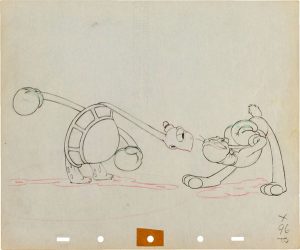 As with the earlier film with Toby and Max, Dick Huemer animates the explosive finale of Toby Tortoise Returns, as Toby’s shell is filled with fireworks, which cause him to batter Max in various methods, to the accompaniment of John Philip Sousa’s Stars and Stripes Forever. The draft mentions these techniques nicely, including a reference to the Motordrome in scene 73, a precursor to racecar events popular in the 1910s and 1920s, where motorized vehicles sped along wooden tracks. Though the draft credits Huemer for scenes 82 and 84, with the skyrocket pulling Max away from the ring, the exposure sheets denote these were re-assigned to Jack Hannah.
As with the earlier film with Toby and Max, Dick Huemer animates the explosive finale of Toby Tortoise Returns, as Toby’s shell is filled with fireworks, which cause him to batter Max in various methods, to the accompaniment of John Philip Sousa’s Stars and Stripes Forever. The draft mentions these techniques nicely, including a reference to the Motordrome in scene 73, a precursor to racecar events popular in the 1910s and 1920s, where motorized vehicles sped along wooden tracks. Though the draft credits Huemer for scenes 82 and 84, with the skyrocket pulling Max away from the ring, the exposure sheets denote these were re-assigned to Jack Hannah.
Rollin Hamilton animates the scenes with the ambulance attendants in the film. Hamilton was the first animator Disney hired at the studio, shortly after he opened in early 1924. In the early 30s, Hamilton was an animator at Warners, for Harman-Ising and Leon Schlesinger. According to Disney’s desk diary for 1936, Hamilton scheduled an appointment with Disney in late February. A month later, Disney suggested that Hamilton animate the hen and rooster scenes in Mother Pluto to Paul Hopkins, the scenes were taken over by Gerry Geronimi instead.
Its possible he also animated on The Worm Turns, judging by the Hamilton and Ham credit in the draft; presumably, Ham Luske would have been busy with his duties for Snow White and the Seven Dwarfs when the short was in production. Hamilton soon left the studio and worked Harman-Ising again, at MGM. Its unclear if animosity between him and Disney, based on his 1928 departure, was the main cause.
 Milt Kahl, in one of his earliest assignments, animates the opening crowd shot in the film. (To correct a previous error from an earlier column, since Kahl was still an assistant animator a year before this film was released, Milt Schaffer would have handled the opening crowd shot in On Ice instead.) Izzie Klein animates Max and Toby in their corners, the scenes of timekeeper Practical Pig, and Max relaxing in an easy chair, smoking a cigar as hes given a shoeshine and manicure during the break in between rounds. In the latter scene, Klein adds a subtle touch; Max winks at the manicurist, which she acknowledges but quickly returns to filing his nails. Marvin Woodward animates a brief section with Max and his three admiring fans, the same boarding school girls from the previous film, and signaling the ambulance attendants to bring a stretcher designated for his opponent.
Milt Kahl, in one of his earliest assignments, animates the opening crowd shot in the film. (To correct a previous error from an earlier column, since Kahl was still an assistant animator a year before this film was released, Milt Schaffer would have handled the opening crowd shot in On Ice instead.) Izzie Klein animates Max and Toby in their corners, the scenes of timekeeper Practical Pig, and Max relaxing in an easy chair, smoking a cigar as hes given a shoeshine and manicure during the break in between rounds. In the latter scene, Klein adds a subtle touch; Max winks at the manicurist, which she acknowledges but quickly returns to filing his nails. Marvin Woodward animates a brief section with Max and his three admiring fans, the same boarding school girls from the previous film, and signaling the ambulance attendants to bring a stretcher designated for his opponent.
The draft for Toby Tortoise Returns is dated April 22, 1936, under its working title Return of Toby Tortoise, three months after animation began. Scene 50 appears to be missing from the document, which occurs after the ambulance attendants pull the stretcher in front of Toby’s ringside corner. It could have been Toby’s reaction, which seems to be animated by Dick Huemer; it matches the closing portions of the film, and he draws Toby’s nostrils nearer to each other than the other three principal animators. Scene 52, which indicates that Toby’s coach pushes him out of the corner to face Max again, seems to have been cut from the film. The cartoon was released exactly four months later, on August 22nd.
The fireworks inside Toby’s shell wouldve fit perfectly yesterday on the Fourth of July, but the day after shouldn’t make a difference, right? Enjoy!
(Thanks to J.B. Kaufman and Hans Perk for their help.)





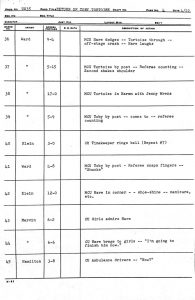

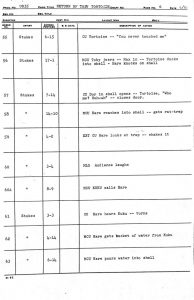

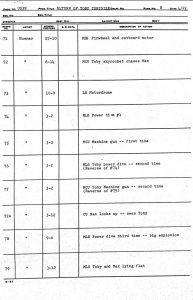

 DEVON BAXTER is a film restoration artist, video editor, and animation researcher/writer currently residing in Pennsylvania. He also hosts a
DEVON BAXTER is a film restoration artist, video editor, and animation researcher/writer currently residing in Pennsylvania. He also hosts a 





















































































I love when Disney sneaks in an adult joke: “I like a man who takes his time.”
Now why didn’t this cartoon win an Oscar? Simply cartooning at it’s best, Disney or not. I think Ward disowned it later in his life, however. Ward was one of the best cartoonists at Disney, but soon the “caricaturists” got short shrift, and the guys who could do serious humans won out. Ward was an official “9 OId Man”, so he probably didn’t want to be typed as a cartoonist. Milt Kahl’s (also a 9 Old Man) opening crowd scene is a bit cycle-y here, not as exciting as his scenes in other shorts, like Mickey’s Circus. I wonder who did the sparkling fireworks effects animation in Dick Heumer’s sequence? Did the exposure scenes credit somebody like, say, Dan McManus? A lot of the scenes pre-figure Tex Avery’s MGM cartoons, the referee that Ward animates feels a lot like Droopy, and the scene where Toby chases Max around the boxing ring, feels like the wolf chases in the Red Hot Riding Hood cartoons. Please do a breakdown on The Worm Turns sometime, Devon, that’s another piece of great cartooning.
It also was obviously an influence on Bob Clampett, whose “Porky & Daffy” certainly seems to pay tribute to this Disney cartoon. I’m sure there’s a bit of latter-day revisionism with Ward disowning “Toby Tortoise Returns”; like all artists, he was probably embarrassed by an early work, especially since his cartooning went so far into highfalutin modernism. Or maybe because so much of the picture was shaped by non-9 Old Men (i.e. pariahs) like Bob Stokes, Dick Lundy, and Dick Huemer? It’s a shame the studio was determined to stamp out everything that makes this cartoon so wonderful. Friz said that guys like Ward were jealous that they never got to do anything as funny as even the Warner potboilers at Disney. Needless to say, “Toby Tortoise Returns” proves “what might have been.”
Thad: I would argue that “The Worm Turns” is another example of “what might have been”.